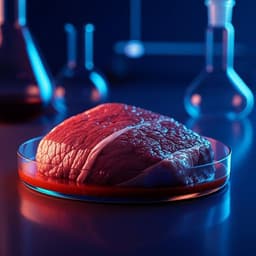
Biology
Improve sample preparation process for miRNA isolation from the culture cells by using silica fiber membrane
W. Hu, Y. Chen, et al.
This study, conducted by Wen-Pin Hu, Yu-Chi Chen, and Wen-Yih Chen, revolutionizes miRNA isolation from cultured cells by modifying a commercial extraction kit. Discover how optimizing ethanol concentration and TE buffer conditions led to an impressive sixfold recovery increase of endogenous miR-21!
~3 min • Beginner • English
Introduction
MicroRNAs (miRNAs) are short noncoding RNAs (18–22 nt) involved in posttranscriptional regulation and are associated with diverse diseases, making their expression profiles valuable diagnostic and prognostic biomarkers. Accurate miRNA analysis depends critically on high-quality nucleic acid isolation, especially when sample volumes are limited. Existing RNA extraction approaches include liquid-phase (e.g., AGPC phenol–chloroform) and solid-phase silica-based methods, where adsorption is governed by chaotropic salts, pH, ionic strength, and solvent composition. Interactions between nucleic acids and silica involve hydrogen bonding, salt bridges, electrostatic forces, and dehydration; monovalent and divalent cations modulate these interactions. Although column-based kits are widely used and generally effective for small RNAs, recoveries vary across kits, indicating room for optimization. This study aims to elucidate and exploit underlying adsorption and desorption mechanisms to modify a commercial silica membrane workflow for cultured cells, with the goal of improving miRNA recovery by tuning ethanol content and Ca²⁺ in adsorption, and pH and temperature in elution, quantified via RT-qPCR of endogenous miR-21 and spike-in miR-39.
Literature Review
Prior work established silica-based solid-phase extraction as a robust approach for nucleic acid purification (Boom et al.), with adsorption driven by chaotropic agents such as guanidinium and modulated by pH and ionic strength. Studies have shown divalent cations (Ca²⁺, Mg²⁺) more effectively promote nucleic acid adsorption to negatively charged mineral or silica surfaces than monovalent cations, via formation of salt bridges between phosphate backbones and deprotonated surface silanols. Increasing ionic strength (NaCl or CaCl₂) enhances RNA deposition on silica, with Ca²⁺ showing stronger effects at equivalent ionic strength. Positively charged silica (e.g., aminosilane- or chitosan-modified) can increase adsorption via electrostatic attraction. Additionally, higher alcohol content lowers solution dielectric constant, reduces nucleic acid solubility, and promotes dehydration, favoring adsorption. Comparisons of commercial kits have reported variability in miRNA recovery, with combined liquid/solid-phase approaches (e.g., certain QIAGEN kits) often yielding higher recoveries, yet optimization potential remains. Elution improvements for larger nucleic acids have been reported by increasing temperature and/or pH to disrupt hydrogen bonds and enhance electrostatic repulsion, but effects for miRNA-scale fragments required systematic evaluation.
Methodology
Cell line: HCT 116 human colon cancer cells (source: Prof. Li-Jen Su, National Central University, Taiwan). Extraction baseline: miRNeasy Mini Kit (QIAGEN) with QIAzol (phenol/guanidine) for miRNA-enriched total RNA from cultured cells following the manufacturer’s protocol (details in Supplementary Information; schematic in Figure 1). Spike-in: Synthetic miR-39 (200 fmole in 2 µL) used as exogenous control; endogenous target: miR-21. Reagents: TE buffer (Tris-HCl 0.2 M, EDTA 0.02 M, pH 8.0; working TE used for elution: Tris-HCl 20 mM, EDTA 2 mM, pH 8.0), ethanol (99.5%), CaCl₂, chloroform, ultrapure water. Synthetic miRNA sequences: miR-39 (5'-UCACCGGGUGUAAAUCAGCUUG-3'), miR-21 (5'-UAGCUUAUCAGACUGAUGUUGA-3'); predicted Tm values: 54.8 °C (miR-39) and 49.2 °C (miR-21). Modified adsorption conditions tested: ethanol volume fractions of 60%, 65%, and 70% (v/v) during binding to silica; addition of CaCl₂ to achieve 5 mM Ca²⁺ during adsorption (performed at the stage where small RNA is bound to the silica column; overall buffer from QIAzol/ethanol measured at pH ~5.5; estimated guanidinium isothiocyanate ~1 M during adsorption). Modified elution conditions tested: raising elution temperature to 55 °C; replacing RNase-free water with TE buffer (Tris-HCl 20 mM, EDTA 2 mM, pH 8.0); and TE at 55 °C. Elution protocol: spin columns placed in a dry bath at 55 °C, eluent added, incubated 5 min, then centrifuged; standard elution done at room temperature as control. RT-qPCR: StepOnePlus platform; RT with TaqMan MicroRNA Reverse Transcription kit (15 µL reaction: 5 µL miRNA sample, 7 µL master mix, 3 µL RT primer; conditions: 30 min at 16 °C, 30 min at 42 °C, 5 min at 85 °C, hold 4 °C). qPCR with TaqMan Small RNA Assays (20 µL reactions: 10 µL Master Mix II no UNG, 1.33 µL RT product, 7.67 µL water, 1 µL assay; cycling: 95 °C 10 min, then 40 cycles of 95 °C 15 s, 60 °C 60 s). Replicates: three biological replicates and triplicate technical wells per condition. Statistical analysis: SPSS v18; one-way ANOVA with post-hoc Tukey for multiple groups; one-way ANOVA for two-condition comparisons; significance thresholds p<0.05 (*), p<0.01 (**), p<0.001 (***). Calibration curve: serial dilutions of synthetic miR-21 from 100 pM to 0.1 fM to derive Ct versus log[M] relationship and estimate miR-21 concentrations from Ct under original and modified protocols.
Key Findings
- Elution temperature effect: Eluting at 55 °C lowered Ct for endogenous miR-21 by ~1.6 cycles compared to room temperature; for spike-in miR-39, Ct decreased by ~0.1 cycle. Both extraction groups (room temp and 55 °C) differed significantly from a spike-in-after-extraction control, indicating losses during extraction. - Elution pH/TE buffer: Using TE buffer (pH 8.0) at room temperature slightly increased Ct (miR-21 by ~0.1; miR-39 by ~0.5) versus RNase-free water. However, TE buffer at 55 °C reduced Ct by ~0.4 (miR-21) and ~0.5 (miR-39) relative to the original elution, indicating improved recovery; significant difference observed between TE at room temperature and TE at 55 °C. - Divalent cations during adsorption: Adding 5 mM Ca²⁺ during adsorption did not improve recovery; Ct values increased (i.e., lower recovery) for both miR-21 and miR-39, with statistical analyses showing no promotive effect and in some cases significant decreases in recovery. - Ethanol concentration during adsorption: Increasing ethanol from 60% to 65% (v/v) decreased Ct for miR-21 by ~0.4; 70% (v/v) decreased by ~0.5 vs 60%, with little difference between 65% and 70% for miR-21. For miR-39, 65% ethanol yielded the lowest Ct and was significantly better than 70%. Overall, 65% (v/v) ethanol was optimal for small RNA recovery. - Combined optimal conditions: Using 65% (v/v) ethanol during adsorption and TE buffer (pH 8.0) at 55 °C for elution decreased Ct versus the original protocol by ~2.6 cycles for miR-21 and ~1.7 cycles for miR-39 (p<0.001). U6 Ct values were similar between protocols (original 19.6 vs modified 20.11; p<0.05). - Calibration and yield gain: The calibration curve for miR-21 showed linearity: Ct = −3.1392 log10[M] − 21.291 (R² = 0.996). Using this, the modified protocol yielded an estimated miR-21 concentration of ~148.6 pM vs ~22.5 pM with the original, corresponding to about a 6-fold increase in recovery.
Discussion
Systematic adjustment of adsorption and elution parameters based on known silica–nucleic acid interaction mechanisms substantially enhanced miRNA recovery from cultured cells. Increasing ethanol to 65% (v/v) during binding improved adsorption via reduced solubility and enhanced dehydration, consistent with entropy-driven adsorption. Contrary to expectations from larger nucleic acids, adding 5 mM Ca²⁺ during adsorption did not help and instead reduced recovery, likely due to low pH (~5.5) limiting silica deprotonation and excessive charge neutralization of small RNAs that weakens hydrogen bonding and alters binding equilibria; miRNAs, with fewer phosphate charges, appear more sensitive to such neutralization than longer RNAs. During elution, elevating temperature to 55 °C and raising pH with TE buffer increased desorption by disrupting hydrogen bonds and increasing electrostatic repulsion between negatively charged miRNA and deprotonated silica. The combined optimal conditions translated to markedly lower Ct values and a quantified ~6× boost in miR-21 recovery, which is expected to reduce variability and improve sensitivity in downstream qPCR, microarray, or NGS analyses. These findings directly address the study goal of enhancing recovery in a silica membrane-based workflow using mechanism-guided parameter tuning.
Conclusion
The study identified mechanism-informed modifications to a commercial silica membrane miRNA extraction workflow that significantly improve recovery from cultured cells. Optimal conditions are 65% (v/v) ethanol during adsorption and TE buffer (pH 8.0) elution at 55 °C. Under these conditions, endogenous miR-21 recovery increased by approximately six-fold versus the original protocol, and spike-in miR-39 also improved. These enhancements are attributable to strengthened adsorption via dehydration (ethanol) and improved desorption through increased temperature and pH. The modified method can yield higher-quality miRNA inputs for genetic testing and analysis. Future work could explore automation, broader validation across cell types and biofluids, compatibility with diverse kits and silica chemistries, and optimization of elution temperatures practical for routine workflows.
Limitations
The authors note a major practical limitation: implementing the modified protocol requires performing the elution step at 55 °C, which may add operational constraints. Additionally, the use of TE buffer introduces EDTA, although at the low concentrations used it did not affect qPCR in this study.
Related Publications
Explore these studies to deepen your understanding of the subject.







